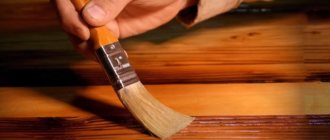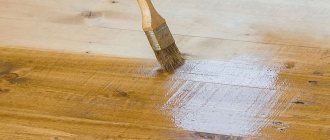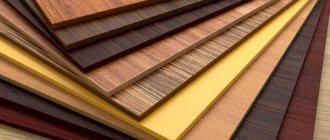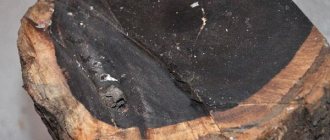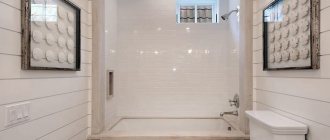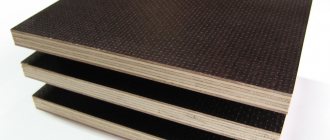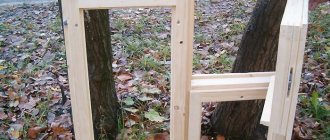Wooden bases do not lose their popularity for a long time, but the material has a disadvantage - it is not resistant to many external factors, which requires the creation of a protective layer; people often want to preserve the natural grain of the wood. Varnish coating is regularly chosen for different types of wood products; although the process seems simple, it requires certain knowledge to obtain a durable and high-quality result. The types of varnish impregnations and operating rules will be discussed in detail below.
Technology of applying varnish to a wooden surface. How to varnish wood correctly?
How to apply varnish to wood?
Our company's technologists will tell you about this. It is best to call us as different products require different approaches. Frequently asked question: what is the best way to apply varnish to wood?
A spray gun is ideal for this purpose (an air gun for nitro varnishes and an airless gun for water painters), but if you don’t have one, you can use a brush or roller. Synthetic brushes are well suited for water-based products, and natural bristles for solvent-borne products.
First we prepare the surface. Hairiness and any shallow gouging defects are removed by sanding. Movements should be carried out in the direction of the fibers. It is best to use an eccentric machine for sanding. Primary processing is carried out with coarse grain 80, finishing with grinding with P 150-240 abrasive.
FAQ:
- How to varnish wood without streaks?
The varnish layer should be as thin as possible. To do this, the applied composition is poured into a paint bath, where excess varnish is removed using a rolling surface. Coloring control is carried out using a table lamp installed at the edge. The light falling on the wood will indicate where there is a lot of varnish and where there is none at all. - How many layers of varnish should be applied to wood?
Usually at least two layers are applied. Some paint schemes require three coats. Between layers it is necessary to maintain the time recommended by the manufacturer for drying. - Is it necessary to coat the wood with varnish after impregnation with primer?
If you need aesthetics, then varnish is needed. If a structure that is not visible is being processed, it is not advisable to apply a varnish composition, and a primer will provide effective protection.
How many layers should I apply?
How many layers to make when varnishing wooden objects worries many novice craftsmen. In this matter, it is important to recommend the manufacturer of the selected varnish. You won’t be able to get by with a single-layer coating, otherwise the protection will not be reliable.
A three-layer application is standard; it is important to wait for each layer to dry completely so that there are no streaks or uneven spots. The first coat is usually considered a primer.
A three-layer application is standard; it is important to wait for each layer to dry completely so that there are no streaks or uneven spots.
Consumption of varnish per 1m2. Coverage schemes
The consumption of varnish per 1 m2 on wood depends on the density of the wood, the type of lumber (planed, sawn), the concentration of paintwork materials and pre-treatment. Typically, on a planed surface, consumption does not exceed 1 liter per 10 m2.
How to treat wood before varnishing so that the consumption of the latter is minimal?
To do this, use acrylic primer, which creates a film on the surface. The absorbency of lumber is reduced, and the consumption of varnish is small.
When painting with brushes, it is recommended to dilute the first layer of varnish with water so that its consistency becomes thinner. The approximate consumption rate of wood varnish per 1 m2 for the first layer is 130 ml. When applying varnish on the ground or as a second layer, the consumption can be halved.
Photo 7. Planken coated with Teknos varnish
Wood tinting
The varnish itself can enhance the appearance of the wood. But sometimes you can pre-tint wood, imitating certain noble varieties. The toner itself is heated to 50 degrees before being applied to wood, after which natural drying occurs at a temperature of 20 degrees. Such products cannot be dried in the sun. Once dry, you can do another light polishing.
Depending on the type of wood, it is best to use the following types of toner:
- Walnut – pine, aspen, plum;
- Ebony - birch, pear, maple;
- Mahogany - linden, beech, walnut.
Important! In the case of tinting coniferous wood, you must first get rid of the resins. Simply wipe the surface with acetone, soda solution or gasoline.
What is moisture-resistant varnish. Do I need to pay extra for it?
Moisture-resistant wood varnish does not allow moisture to pass through and does not release it back, as a result of which water does not accumulate under the film and does not destroy the paint layer. However, moisture-resistant varnish is more expensive, so it is advisable to use it in conditions with high humidity - a street where rain and snow have a detrimental effect on wood, a bathroom, a kitchen, a sauna. If the room is dry, there is no point in overpaying for moisture resistance.
Felt
To sand the varnish, you will need a homemade sanding block and pumice powder. This block is made from a piece of board and a piece of felt, which can be found in any building materials store. Felt 10 mm thick is attached to a wooden plate (it will serve as a handle) using tape treated on both sides with adhesive.
Gentle effect
Felt promotes uniform distribution of pumice powder, softens its effect on the varnish coating, resulting in no grooves or scratches left on the surface. The water with which the pumice powder is moistened also protects the varnish layer from damage. Each time after sanding, the felt must be washed, as it absorbs some of the sanding paste. It can be easily removed.
Thin felt, which is used, for example, as a floor covering, is not suitable for sanding. Satisfactory results can only be achieved when working with thick felt that has a smooth surface, which cannot be said about felt flooring with grooves. Because of them, the pumice powder will not be distributed evenly.
Homemade device for sanding varnish: glue a piece of thick felt to a wooden plate that serves as a handle.
What varnishes have a smell? Is it harmful to human health?
Paints and varnishes based on organic solvents are endowed with a pungent odor that causes headaches, nausea or allergies in humans. Such symptoms indicate pathological processes in the body. Paintwork materials with a strong odor are certainly harmful. Such products must be used for their intended purpose, in specially equipped rooms with fresh ventilation.
Odorless, water-based wood varnish is an absolutely safe product for humans. Water-soluble varnishes are very popular today. They are environmentally friendly and have excellent technical characteristics. The coating is aesthetically pleasing, lasts a long time, and does not crack under the influence of sunlight.
Surface preparation
Whether the sanded varnish will turn out beautiful depends largely on the quality of the base. An impeccably prepared surface is one of the conditions for its successful finishing.
However, only hard wood with a stable structure is suitable for varnishing. For a product made from soft wood, the structure of which is heterogeneous (it changes as the wood ages), the surface after some time begins to resemble a washboard, and the appearance of the product - with or without a varnish coating - naturally turns out to be spoiled. This does not happen with hard rocks.
The first stage of surface preparation is grinding, which smoothes out irregularities and removes protruding cut fibers. Any wood dust that appears should be carefully collected with a vacuum cleaner. The latter has a great advantage over a brush or broom, since it does not raise dust.
Primer
A primer is applied to the sanded surface. It will fill the pores of the wood and strengthen its structure. Also, thanks to the primer, the subsequent putty and the first layer of varnish will not penetrate too deeply into the wood. The primer is applied in a thick layer. It should dry well. After this, 180-grit sandpaper is used to clean off the raised fibers and smooth out any irregularities.
Sand the untreated wood with sandpaper in the direction of the grain. The sanding block provides a smooth contact surface between the paper and the wood.
The primer is applied in a thick layer and sanded after drying. Sanding dust should be removed very carefully.
Consumption
In order to correctly calculate how many cans of varnish will be needed to treat a certain area, you should make some calculations.
First you need to pay attention to the criteria that play an important role when spending funds:
- Wood surface. Wood with fine pores always requires less varnish than surfaces with deep pores. For example, processing beech or pine will cost much less than painting ash or oak.
- Wood sanding quality. A well-polished surface always requires little varnish. For high-quality sanding of the material, you should use sandpaper with P100 grain. To create the second layer, use P220 sandpaper.
- Viscosity. Thick varnish will have a high consumption. To reduce it slightly, the first and second layers of application can be carried out with varnish diluted with a solvent. If the product is water-based, then you can add a little water to make it more liquid.
- Method of application. If you use spraying, the consumption will be minimal. Using a brush or roller increases the product consumption significantly.
On average, varnish consumption per 1 m² is 100–125 ml. It will take less to create a second coat of varnish. So, per 1 m² you will need only 80–100 ml. But the factors described above play a decisive role, so for an accurate calculation you can purchase a can of varnish, use it and measure the area. This will allow you to make a very accurate calculation.
Suitable varnishes
A sanded varnish coating, already during the application process, is subjected to significantly greater loads than a conventional varnish coating during its entire service life. Therefore, for matte varnishing of surfaces, it is recommended to choose only the best varnishes. They must cover the base with the thinnest and at the same time very durable layer so that it can be sanded.
Acrylic varnishes are not suitable for this purpose. Alkyd resin varnishes give good results. However, the quality of the varnish can be judged by how much it costs. Cheap varnishes, as a rule, are not suitable for this method of surface treatment.
Varnishes for a matte finish and shiny opaque varnishes lend themselves well to sanding. But the former are still preferable because they contain fewer solid particles that can scratch the surface. However, no matter what varnish you choose - matte or opaque, each layer must dry for at least twelve hours before you can start sanding it.
Manufacturers
Today, many well-known companies offer a wide selection of high-quality wood varnishes.
Italian products are in great demand. Borma Wachs has established itself as a high-quality and reliable manufacturer of products intended for processing natural wood.
The Italian brand Sayerlack offers more than 3,500 items, which fully satisfies the needs of woodworkers and furniture manufacturers.
The Finnish company Tikkurila is a popular manufacturer of water-based varnishes for coating parquet boards. It uses exclusively new technologies and computerized equipment to create high-quality and reliable products. The brand offers a wide range of wood varnishes that are characterized by increased wear resistance.
The Swedish company Bona has been offering high-quality water-based paints and varnishes that do not have a characteristic odor for several decades. The brand has its own research center, where innovative products are developed.
This center developed a unique varnish made from polyurethane particles Traffic . It allows you to give the coating increased wear resistance, as well as protect it from mechanical influences, as a result, Traffic varnish is used to cover parquet in high-traffic areas.
The German brand Berger offers a wide range of water-based parquet varnishes, characterized by excellent quality. Berger Aqua-Seal polyurethane varnish is in great demand, which not only has increased wear resistance, but also protects wooden parquet from chemical attack. The only exceptions are nitro solvents, since they can damage the structure.
The Italian company Vermeister is a well-known manufacturer of water-based polyurethane varnishes, which include two components and are designed to create a matte, semi-matte and semi-gloss surface. Aqua Play 2K varnish hardens in just four hours. The company offers products at reasonable prices.
Advantages of lacquered furniture
- Natural wood in its entirety is not only associated with ecology, but also looks attractive in any interior, no matter what style you choose. Varnishing - whether glossy or matte - gives the wood a touch of sophistication, nobility and some monumentality.
- The varnished surface is incredibly easy to clean, because any stains and fingerprints are erased in a second.
- In addition to external advantages, lacquered furniture is reliably protected from dirt, dust and moisture, as well as from accidental mechanical damage.
- One of the main advantages is the ease of restoration: there are special care products that we will look at a little later.
Useful tips
To properly apply varnish to a wooden surface, you should follow simple rules:
- The surface of natural wood needs to be sanded.
- If the wood is coated with varnish or paint, then these layers must be removed. You can use sandpaper or a special remover.
- All dust must be removed after sanding.
- Prime the surface. This will avoid the formation of bubbles and other visual defects.
- Apply varnish to the wooden surface.
There are several ways to varnish a wooden surface:
- The brush is ideal for processing small parts, as well as for applying product in hard-to-reach places. To avoid streaks, you should use brushes that have “fluff” at the tips of the bristles.
- A roller is a good choice for applying varnish over large areas. When choosing a roller, you should give preference to models with a pile of no more than 5 mm.
- Spraying is a convenient way of painting using a spray gun and compressor. This option allows you not only to save varnish consumption, but also to quickly and easily treat even hard-to-reach places.
Before use, the varnish should be mixed thoroughly, especially if the product includes two components. This will have a positive effect on the durability of the coating.
If the varnish needs to be applied in several layers, then you need not only to wait for the previous layer to dry completely, but also to go over the coating with sandpaper and then remove all the dust.
The number of layers depends on what can be processed. For example, to paint furniture, two layers will be enough, but for flooring you will need to apply varnish three times.
How long does it take to dry
When the layer has been applied, sanding is carried out, but sandpaper can only be used on a dry base. The drying period depends on the brand of varnish and is determined by the ingredients used; this information is indicated on the packaging.
The drying period depends on the brand of varnish and is determined by the constituent substances that were used.
What is the difference between wood varnish for exterior and interior use?
Experts divide paint and varnish materials according to several criteria, one of which is operating conditions. Thus, products located in the open air are subject to the negative effects of natural factors, due to which the tree constantly swells and contracts. In this regard, varnishes for external use form an elastic film on the treated surfaces, which allows the wood to easily withstand regular changes in size.
At the same time, it is impossible to use compositions intended for interior work for these purposes - such materials do not have sufficient elasticity, and therefore will not be able to provide the surface with the necessary protection.
Proper care of lacquered furniture
As we already know, varnish coating reliably protects wood from any external influences, even mechanical damage. Caring for a varnished surface is extremely simple and does not require any special skills.
To clean furniture from dirt you may need:
Soft microfiber cloth
It practically does not electrify the surface, and also does not leave streaks on it.
Cotton swabs or soft brush
They will come in handy if there are stubborn stains on the furniture.
Thin soft leather or suede
An easy way to add shine to a varnished surface after cleaning.
Methods for cleaning lacquered furniture:
- Special wipes for lacquered furniture
They contain antistatic substances and wax-like ingredients that give the surface a pristine shine and cleanliness.
- Protective polish
Rub into the surface with a microfiber cloth. Visibly renews the varnish, removing visible traces of use. Application does not require any special skills.
- Another method is cleaning with ammonia (1 part alcohol mixed with 6 parts water).
- You can also use wax melted over low heat. In this case, a clean linen cloth is used, with which the wax is thoroughly rubbed into the varnished surface.
- For cleaning purposes, do not use soap solutions or alkaline compounds, as they can damage the varnish. The same applies to abrasive sponges.
Reviews: advantages and disadvantages
Varnishes for exterior use have a number of advantages, the main ones being: high protective performance and the ability to preserve the unique texture of wood. High-quality compositions have increased wear resistance, resistance to ultraviolet radiation and moisture. At the same time, the varnish coating also provides the wood with protection from rotting and fire, which has an extremely positive effect on the service life of the product.
Some experts and consumers consider the disadvantages of varnish compositions to be a rather long drying time - it often takes more than 24 hours to completely dry the coating.
Sanded varnish
Until recently, the concept of “matte varnish” was associated with something tasteless and bourgeois. This meant elaborate dressing tables in the Baroque style and pompous bedroom sets with a polished varnish finish. But in fairness, it should be noted that not all pieces of furniture with such a coating look vulgar.
Applying varnish followed by sanding is a rather complicated procedure. In addition, the varnish is applied layer by layer and each one is carefully sanded, not immediately, but only after the varnish layer has completely dried and hardened. It is clear that all this takes a lot of time. But there is no other way. Only if all the rules are fully and precisely followed, the coating will be perfectly smooth and beautiful.
It is no coincidence that a sanded varnish coating, made by hand according to all the rules, compares favorably with a similar - by definition, but not in quality - coating that can be seen on factory-made furniture, which, by the way, became the reason for the bad reputation of matte varnish.
For the home craftsman, using the varnish sanding technique can be a good practice in mastering various methods of finishing the furniture he has made.
A sanded varnish coating is considered flawless if not a single recess or frozen speck of dust is visible on it. After the final sanding, the surface should become uniformly matte. Therefore, it is not easy to avoid the temptation to apply another layer of varnish and sand it to obtain an ideal surface that does not lose its noble “velvet” shine over the years.
Where to buy wood varnish?
In Moscow
In Moscow, you can purchase varnish for exterior woodwork from companies such as:
- “Paints on the Sofa”: website: https://kraskinadivane.ru;
- address: Moscow, Taldomskaya street, building 17, building 1;
- telephone.
- website: https://stroycolorit.ru;
- website: https://www.krasko.ru;
In St. Petersburg
In St. Petersburg, the following organizations sell wood varnishes:
- “Petrovich”: website: https://petrovich.ru;
- address: St. Petersburg, 6th Verkhny lane, building 12A;
- telephone.
- website: https://olvia-color.ru;
- website: https://vlagoshchit.rf;
Thus, a properly selected varnish for exterior use can not only reliably protect wood from the harmful effects of external factors, but also preserve its natural texture almost unchanged.
In the next video you will find a review of Kudo KU-904x tinting varnish for wood.
Alternately varnish and sand
When the first layer of varnish is completely dry, start treating the surface: apply a mixture of pumice powder and water to it and sand it section by section with a homemade block. Try to treat the entire surface, including corners and edges - this is very important. If you think you have achieved your goal, wipe a small area of the surface with a clean cloth and check what condition it is in and whether you need to continue working.
If the sanding quality of the varnish meets your requirements, clean the entire surface of the pumice paste as thoroughly as possible with a wet cloth, allow the surface to dry, and then remove any remaining stains with a dry cloth. After this, you can apply the next layer of varnish.
Layer by layer
After applying the second layer of varnish, the surface is also sanded and then thoroughly cleaned. If the results satisfy you, the work can be considered completed. But according to all the rules, one more - third - layer of varnish is required. Five and even six layers are no exception. It is with a multi-layer varnish coating that the surface will acquire a uniform color.
A mixture of pumice powder and water is rubbed into the varnish layer. As a result, the transparent and shiny coating becomes matte. The surface is cleaned of paste first with a wet cloth, then with a dry one.
It is necessary to apply and sand at least three layers of varnish to ensure a flawless surface. But five and even six layers are no exception.
Using wood stain
The wood surface should be painted with stain in the same way as with regular paint. The only thing is that this impregnation dries very quickly, so you should work just as quickly, but carefully .
Before completing the work, you must not allow the stain layer to dry, otherwise a seam in this place will be clearly visible, different from the rest of the surface. That is why you should not put a lot of solution on the brush.
To paint a wooden surface with stain, use:
- Paint brush.
- Foam roller.
- Automatic or manual sprayer.
The stain is applied parallel to the direction of the wood grain and therefore should not be applied to another section unless the first is finished. In the place where the two sections are connected, it is necessary to ensure that the applied layers of impregnation do not overlap each other.
Thanks to stain, wood acquires a refined and excellent color . In addition, it protects and enhances the wood grain. After the planed plank floor is laid, it is necessary that it is always clean, otherwise, after applying the stain, all the stains will begin to stand out.
If there are greasy stains on the floor, the stain in this area may not be absorbed into the wood. If the wooden parquet is in good condition and there is no need to restore or putty it, then covering it with such impregnation is an excellent solution to renew the old parquet.
If you need to get a new shade, you can mix several stain colors. You need to stir carefully so that splashes do not fall on the floor, as such stains will subsequently stand out very strongly. It is recommended to mix only compatible components.
Why apply stain to wood?
To better protect the wood flooring and extend its service life, it is recommended to treat it with stain. This impregnation penetrates deeply into the pores of the wood and enters into a chemical reaction with tannins located in the growth rings, giving the wood a light- and water-resistant color.
In addition, stain protects the wood from borers, mold fungi and other infections and pests. Modern liquid stains come in the following types:
- oil;
- alcohol;
- aquatic.
Let us consider their characteristic properties in more detail.
Water stain
This impregnation comes in two types: in the form of ready-made solutions that can be used immediately, and in powder form. A solution should be prepared from it. Water stain does not require drying oil , white spirit and other solvents.
However, it has one significant drawback: when the impregnation penetrates into the wood, it lifts its fibers , leaving the wood unprotected from excess moisture.
But, on the other hand, with the help of such wood processing, its structure is emphasized and highlighted. Therefore, today this type of stain is considered the most common.
Alcohol stain
This impregnation is a solution of aniline dye in ethyl alcohol. It is used for decorative and antiseptic painting of wood products. With the help of alcohol stain, pile lifting is reduced and wood swelling does not occur.
Using this type of stain, it is quite difficult to achieve uniform coloring, because the composition dries very quickly and stains can form . This impregnation is best suited for tinting small products, but it will not be suitable for painting parquet.
Oil stain
This impregnation is a dye dissolved in flax oil. It is the most convenient to work with and can be applied in different ways. Oil stain does not lift fibers and is evenly distributed over the entire wooden surface. Products processed in this way can always be easily repainted and restored .
